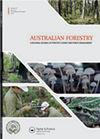印尼日惹一个cajuput种子园的花粉传播和遗传结构
IF 1.2
4区 农林科学
Q3 FORESTRY
引用次数: 2
摘要
仙人掌(千层木);因其药用叶面精油而在印度尼西亚广泛种植。枣子育种项目建立了种子园,提供改良种子,支持建立大面积种植园。了解种子园花粉的传播和遗传结构对提高种子园种子的遗传质量具有重要意义。我们分析了印度尼西亚日惹一个枣种子园160棵树和10棵母树的240个后代的8个微卫星位点。研究了其遗传结构和遗传、花粉传播模式和花粉污染率。亲本表现出较高的遗传多样性(HO = 0.480, HE = 0.755),但约5%的等位基因未被后代遗传。枣树种子园内的花粉传播呈全局性分布,平均花粉供体数(Nep)为17个,平均花粉传播距离为43 m。然而,11.6%的基因型存在不匹配,表明花粉污染来自附近未选择的枣树。刺激种子园内同步开花,为传粉昆虫提供适宜的栖息地,有助于优化种子园内的异交和随机授粉,从而充分捕获遗传多样性,减少花粉污染。本文章由计算机程序翻译,如有差异,请以英文原文为准。
Pollen dispersal and genetic structure in a cajuput (Melaleuca cajuputi subsp. cajuputi) seed orchard in Yogyakarta, Indonesia
ABSTRACT Cajuput (Melaleuca cajuputi subsp. cajuputi) is cultivated widely in Indonesia for its medicinal foliar essential oil. Breeding programs of cajuput have established seed orchards for the provision of improved seed to support the establishment of large areas of plantations. Information on pollen dispersal and genetic structure in such seed orchards is important for enhancing the genetic quality of seed produced from these seed orchards. We analysed eight microsatellite loci in 160 established trees and 240 offspring of ten selected mother trees in a cajuput seed orchard in Yogyakarta, Indonesia. We investigated the genetic structure and inheritance, pollen dispersal patterns and rates of pollen contamination. The parent trees showed high genetic diversity (HO = 0.480, HE = 0.755), but approximately 5% of alleles were not inherited by the offspring. Pollen dispersal in the cajuput seed orchard was panmictic, with an average pollen donor number (Nep) of 17 and an average pollen dispersal distance of 43 m. However, 11.6% of genotypes contained a mismatch, indicating pollen contamination from nearby unselected cajuput trees. Stimulating synchronous flowering in the orchard and providing suitable habitat for pollinating insects may help to optimise outcrossing and random pollination within the seed orchard and thereby to fully capture genetic diversity and reduce pollen contamination.
求助全文
通过发布文献求助,成功后即可免费获取论文全文。
去求助
来源期刊

Australian Forestry
FORESTRY-
CiteScore
3.70
自引率
4.80%
发文量
15
审稿时长
>12 weeks
期刊介绍:
Australian Forestry is published by Taylor & Francis for the Institute of Foresters of Australia (IFA) for scientific, technical, and professional communication relating to forestry in the Asia Pacific.
 求助内容:
求助内容: 应助结果提醒方式:
应助结果提醒方式:


